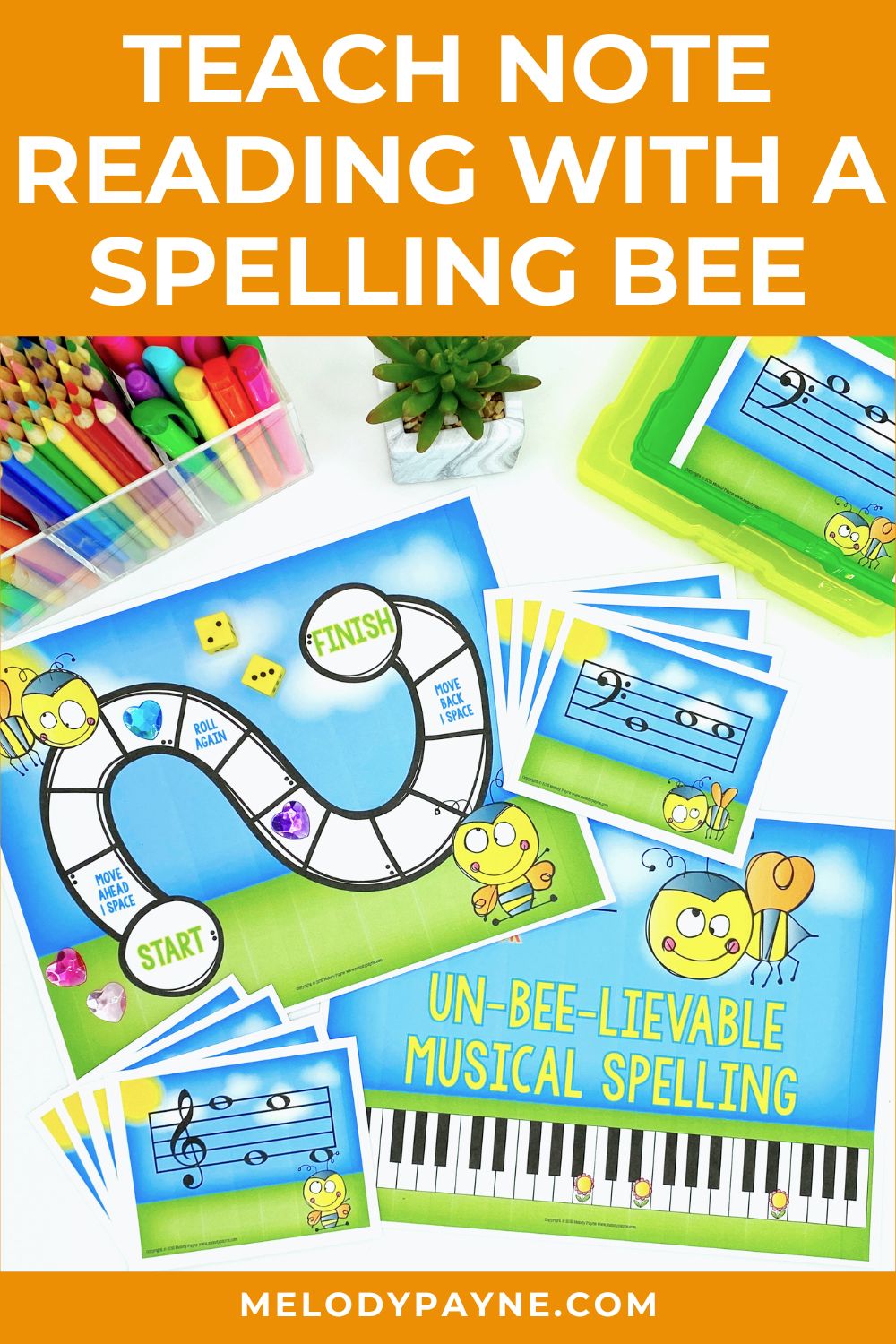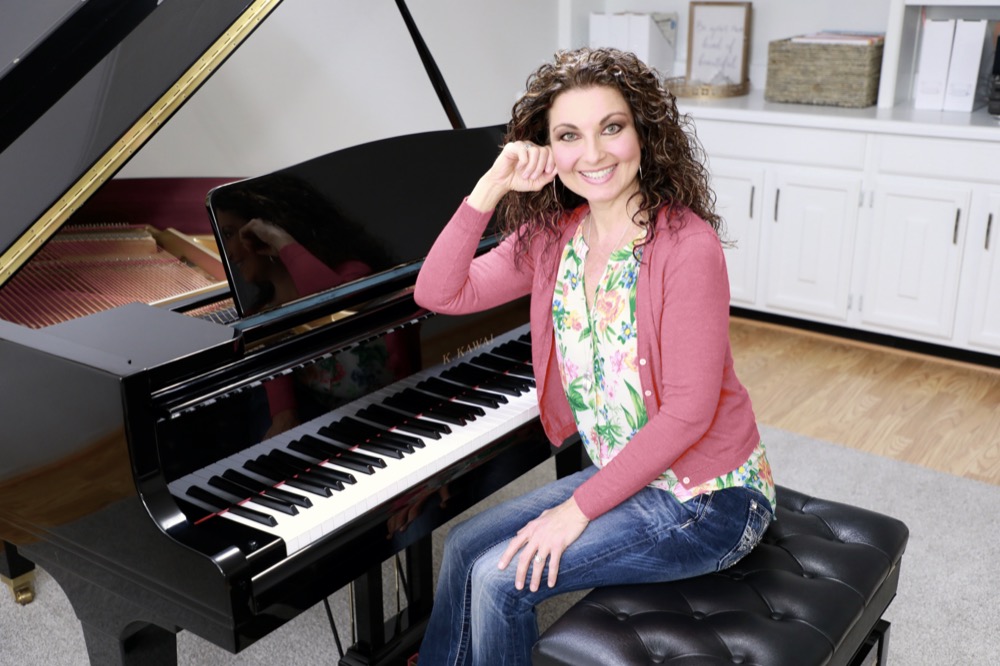Ten Tips for Using the Springtime Musical Spelling Bee Game at Piano Lessons
This post may contain affiliate links. If you purchase something through an affiliate link, I will receive a small commission at no cost to you. For more information, read the disclosure statement here.

Looking for an enjoyable piano lesson game that will help reinforce note-reading skills and produce loads of giggles from your young students? What teacher doesn’t need alternatives to just assigning more theory worksheets?
The Springtime Musical Spelling Bee Game is an affordable, reusable resource that really gives you excellent value for your money AND solves the problem of having to print out more theory pages.
Contents of Musical Spelling Bee Note Reading Game
- Suggestions for use in a variety of situations
- A list of all the words on the 40 treble clef cards
- 40 treble clef spelling bee cards
- A list of all the words on the 40 bass clef cards
- 40 bass clef cards
- Full-page images of both the treble clef and bass clef cards for projecting or using with an iPad
- Game board
- 4 different kinds of certificates
- Assessment pages
Spelling Bee Game Cards
These cards are attractive in every way possible. When you print them out, there are four to a page. Thus, the size of the staff and the notes on each card are large, so students will think it looks “easy”.
Each card contains anywhere from three to five-letter words on them. Two cards have a six-letter word on them. All cards have a springtime background showing the sky, sun, grass, and the cutest little cartoon bees you’ve ever seen.
Each bee has a goofy expression that is sure to add to the fun of this game. You can print out the game cards and game board in full color or use the printer-friendly (black and white) version instead.
Either way, this spelling bee game is sure to be a hit with students!
Assessment Pages
For those teachers who want to use this game as an assessment, there is space on these pages for the student’s name. Then, there is a chart with Word 1, Word 2, etc. on it.
The teacher can either put a checkmark indicating that the student got it right, and/or write the word that they “spelled” correctly. There’s space on each page for up to 40 words.
Tips for Using the Musical Spelling Bee Game
Without the game board:
- During a private lesson when you need a break from playing piano pieces, shuffle the cards. Place them on the music stand. Have your student pick a card, identify the notes, and play them on the piano. Bonus points if your student can also say the word (e.g. ace, Abe, fee, etc.).
- If you want to make the activity more competitive for the student, proceed as above, but add a twist. Tell the student that if they play and identify the notes correctly, they keep the card. If not, they return it to the back of the deck. Play until the student has successfully identified and played all the words on a predetermined number of cards or when the time runs out.
- Piano students who need to practice just their bass clef notes or just their treble clef notes can do so. Simply separate the cards into two piles, treble clef and bass clef. Have the student choose only the cards from the appropriate pile.
- Do you teach guitar, voice, or any other treble clef based instrument? Have your student use only the treble clef cards. Do you teach bass guitar, cello, or another bass clef instrument? The bass clef cards would be useful here.
- For a group class, students can take turns drawing cards, saying the note names, and playing them on the piano. The winner is the person who has the most cards at the end of the game.
With the game board:
- The game board has 13 spaces from start to finish. As always, the ever-present bees are there to keep students company as they move along the path. You’ll need a die and a marker for your student. With one player, proceed as in number one above. But this time, when the student successfully identifies the notes and plays them on the piano, they roll a die. Next, they advance their token on the game board. The game is over when they reach the finish line.
- This game is so much fun in a group class! Proceed as above, but students take turns drawing cards, playing the notes on the piano, and rolling a die. I don’t recommend rolling more than one die unless you want the game to end very quickly. If a player does not play and/or identify the notes on the card correctly, he does not roll the die and his token does not advance. Then, the second player draws a card, etc. Whoever reaches the finish line first, wins!
- With a group of students, show a full-page image of a musical spelling bee card. You can show it on your computer screen, project it, or print out the pages and hold them up, one by one. Students have to race to the piano and play/say the spelling word. The first person who does it correctly rolls the die and advances their token on the game board.
- Laminate the flashcards and game board, and let students borrow it for a week. They can play it at home alone or with a sibling who knows their notes.
- I printed out four of the full page size musical spelling bee flashcards, and they look like beautiful posters! I am displaying one card per week at the entrance to the studio for the next four weeks. Each student will be challenged to “spell” the notes on the piano at the beginning of their lesson. They’ll then be able to advance their token on the game board according to the roll of their die. Which lucky student will make it to the finish line? A small treat awaits them!
Online:
If you have virtual piano students and are wondering if Music Spelling Bee will work for online lessons, it will! Check out 3 Easy Ways To Use Printable Games In Online Piano Lessons to learn how to adapt it for online lessons.
Musical Spelling Bee Game Certificates
For those teachers who want to make this activity extra special, there are four different styles of certificates. The spelling bee theme continues. One says, “For a BEE-UTIFUL job”, and another says, “For UN-BEE-LIEVABLE MUSICAL SPELLING”.
Looking for Additional Spelling Activities?
In addition to the Springtime Musical Spelling Bee Game, did you know there’s also a Valentine’s Day version?
And here are a variety of other spelling-related activities that are created just for your students!
Storing and Organizing the Game Cards
These colorful 4×6 photo boxes (affiliate link) are perfect for storing and organizing the game cards. They are highly recommended because they’re the perfect size, and the colors are vibrant and fun!
Grab the Springtime Musical Spelling Bee Game today, laminate it, and use it for years to come. Watch your students’ note-reading ability improve as they enjoy playing this exciting game!
If you liked “Musical Spelling Bee Game,” you might also like…
Don't miss out!
Follow on Facebook and Instagram, join the best Facebook group for piano teachers, and subscribe to the newsletter to get helpful teaching tips, resources, and tutorials delivered straight to your inbox every week.
Celeste-tina Hernandez
Celeste-tina Hernandez
Welcome!

Hi! I’m Melody Payne, a pianist and piano teacher, educational resource author, a fun-loving wife to the most wonderful and talented hubby I could ask for, and a lifelong learner who loves to share. I want to make your life as a music teacher easier by writing and sharing helpful and relevant music teaching articles, and by creating educational resources with your very own students in mind. If you are a parent who wants to enroll your child in piano lessons, I’d love for us to get started building those skills that can give your child a lifetime of musical enjoyment!





This Post Has 2 Comments
Looks like fun for kids of all ages. The reality with kids is that happy kids make for happy parents.
I agree! And happy kids at lessons = happy teacher!